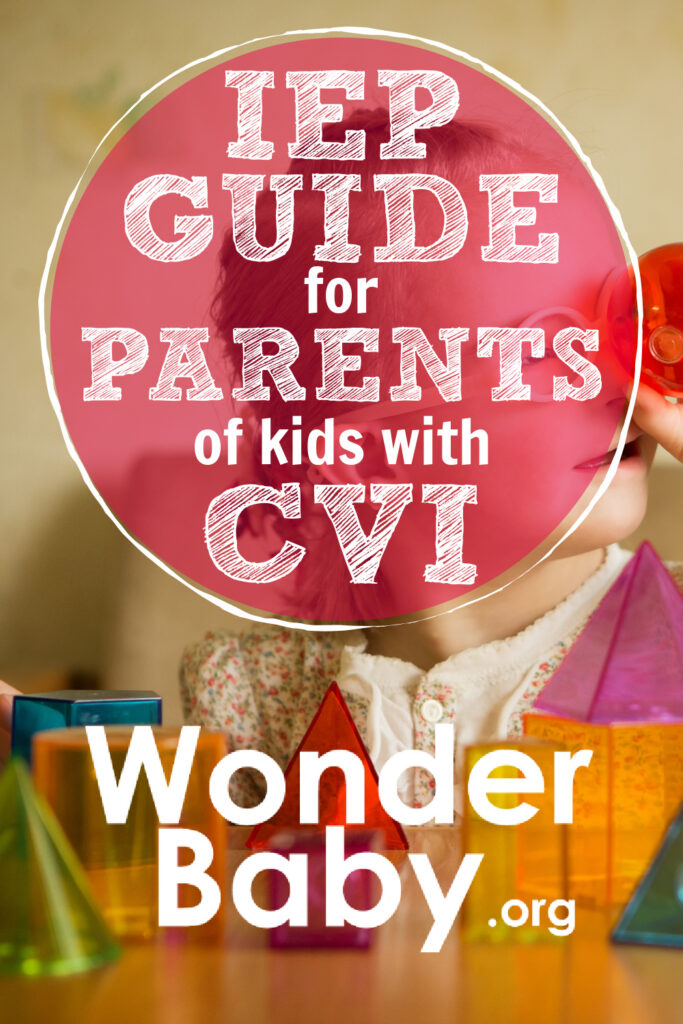CVI Now Creates IEP Guide for Parents of Kids with CVI

Any parent who’s ever felt sweaty, clammy, and cold in an IEP meeting knows: It’s overwhelming. You feel at a disadvantage. You’re caught between wanting to be diplomatic and wanting what’s best for your kid, no matter what.
That’s why the CVI Center at Perkins created the CVI Now IEP Guide—a comprehensive, productive, and solutions-oriented resource.
Cortical/Cerebral Visual Impairment (CVI), a brain based visual impairment, is the leading cause of childhood blindness. CVI is caused by an interruption or damage to the visual pathways of the brain. Often, people associate blindness with an eye condition. With CVI, the eye’s connection to and in the brain doesn’t work correctly. Individuals with CVI struggle with visual attention and visual recognition resulting in a lack of access to, and understanding of, the world around them. CVI is lifelong.
With CVI, every individual person’s lived experience is different. When it comes to creating an accessible education, children with CVI need: a comprehensive whole-child CVI assessment to evaluate the CVI visual behaviors and how the child uses compensatory skills; a multisensory approach to learning; intentional and systematic instruction; and ongoing evaluation to ensure the learning environments and tasks are accessible throughout the school day.
CVI is not new, it’s been misunderstood and misdiagnosed. Individuals with CVI have a right to comprehensive assessment, effective interventions, and accessible educational programs. A well-written Individualized Education Program (IEP) and a collaborative, dedicated school team empowers kids with CVI with life-changing access.
We know how stressful navigating the IEP process can be. We also know how important it is for parents to have a deep understanding of how an IEP is developed and implemented. As parents of kids with disabilities, we have to learn a whole new set of skills to advocate for services and interventions.
That’s why we wrote this guide.
We cover parts of the IEP, steps of the process, what to expect, and include CVI-specific information and advice every step of the way.
Even if your child does not have a CVI diagnosis, this IEP guide is a valuable tool to better understand the IEP process, what parents need to know, how to advocate for your child, and how to speak the language.
Some big takeaways from the CVI Now IEP Guide
- Assessments drive the IEP. Students with CVI require comprehensive whole-child assessments that include CVI assessments, the Learning Media Assessment (LMA), and an Orientation and Mobility Assessment.
- Assessment data drives the development of accommodations and supports for your child’s IEP. Accommodations should reflect need areas identified by assessment and integrate your child’s CVI visual behaviors.
- Present levels are a comprehensive, baseline summary of your child’s strengths, challenges, and needs. Present levels must include objective data based on assessment results and ongoing progress monitoring. This data must also capture the conditions (accommodations, adaptations, environment).
- Goals and objectives should be connected to assessment results and the current levels of performance, and incorporate CVI and the whole-child needs. CVI affects all aspects of learning.
- Services and placement should be tied to each of your child’s goals. For students with CVI, vision services should not be based on acuity alone, but reflect the needs that come from vision assessments and the goal areas.
- Systematic instruction and ongoing data collection is essential to ensure an appropriate and accessible educational program. Data, data, data: Anecdotes without data are meaningless.
- Parent collaboration is critical – they have the most observational data of their child, deeply understand their child’s unique needs, and often have learned A LOT about CVI.
- It’s about access to learning and what needs to be in place to remove the barriers to access caused by the CVI. CVI is a big deal, no matter how it manifests. All individuals with CVI are on the blindness spectrum.
This guide is part of CVINow.org, a go-to source for trusted answers and resources about CVI. CVI Now is current, inclusive, and follows the research and science, empowering families with the CVI knowledge, guidance, and tools you and your child need to succeed.
For CVI parents/guardians, there’s a CVI Now Parent Facebook group where you can connect with and learn from other CVI families — to ask your questions and get answers. Angela, a CVI Now parent wrote, “CVI Now offers connection with others who have similar life experiences, along with empathy, hope, joy, and perseverance we need to lead this charge.”
Every child with CVI has the right to an early diagnosis, effective vision services, and access to appropriate educational programs. Every child with CVI is teachable and has abilities and gifts to share with this world.

Related Posts

Eye Conditions and Syndromes, Visual Impairment
Neuralink Announces Plans to Restore Sight to the Blind with Brain Chip
Elon Musk’s company Neuralink has announced plans to begin human trials of its new “Blindsight” brain chip by the end of 2025.

IEPs
What Should I Bring to My Child’s First IEP Meeting?
Prepare for your child's first IEP meeting with confidence! Discover exactly what documents to bring, including educational records, medical info, and questions to ask.

Visual Impairment
The Gift of Understanding: How a Young Child Helps His Blind Father Navigate Life
When a parent is blind, it’s natural for people to wonder how their sighted child will adapt. Will they struggle to understand their parent’s needs? Will they feel burdened by...